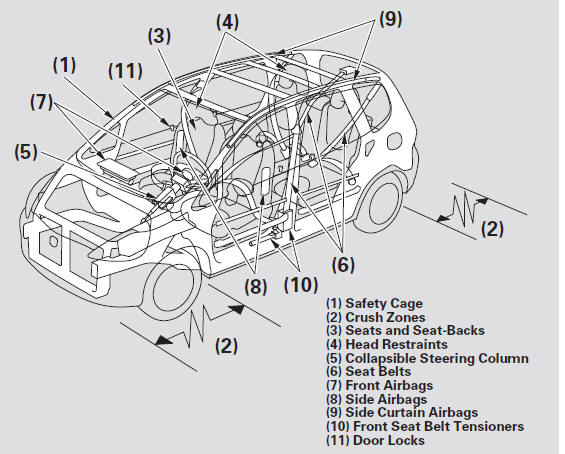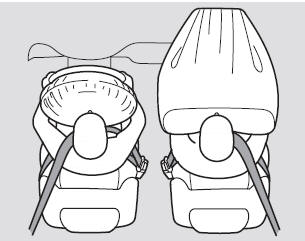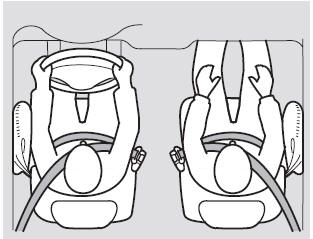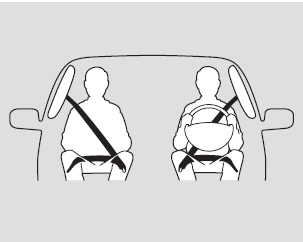Honda Fit: Your Vehicle’s Safety Features

Your vehicle is equipped with many features that work together to protect you and your passengers during a crash.
Some features do not require any action on your part. These include a strong steel framework that forms a safety cage around the passenger compartment, front and rear crush zones, a collapsible steering column, and tensioners that tighten the front seat belts in a crash.
However, you and your passengers can’t take full advantage of these features unless you remain sitting in a proper position and always wear your seat belts
. In fact, some safety features can contribute to injuries if they are not used properly.
The following pages explain how you can take an active role in protecting yourself and your passengers.
Seat Belts
Your vehicle is equipped with seat belts in all seating positions.
Your seat belt system also includes an indicator on the instrument panel and a beeper to remind you and your passengers to fasten your seat belts
Why Wear Seat Belts
Seat belts are the single most effective safety device for adults and larger children. (Infants and smaller children must be properly restrained in child seats.) Not wearing a seat belt properly increases the chance of serious injury or death in a crash, even though your vehicle has airbags.
In addition, most states and all Canadian provinces require you to wear seat belts.

Not wearing a seat belt properly increases the chance of serious injury or death in a crash, even though your vehicle has airbags.
Be sure you and your passengers always wear seat belts and wear them properly.
When properly worn, seat belts: • Help protect you in almost every type of crash, including frontal, side, and rear impacts and rollovers.
• Keep you connected to the vehicle so you can take advantage of the vehicle’s built-in safety features.
• Help keep you from being thrown against the inside of the vehicle and against other occupants.
• Keep you from being thrown out of the vehicle.
• Help keep you in a good position should the airbags ever deploy. A good position reduces the risk of injury from an inflating airbag and allows you to get the best advantage from the airbag.
Of course, seat belts cannot completely protect you in every crash. But inmost cases, seat belts can reduce your risk of serious injury.
What You Should Do:
Always wear your seat belt, and make sure you wear it properly.
Airbags

Your vehicle has a supplemental restraint system (SRS) with front airbags to help protect the heads and chests of the driver and a front seat passenger during a moderate to severe frontal collision .

Your vehicle also has side airbags to help protect the upper torso of the driver or a front seat passenger during a moderate to severe side impact.

In addition, your vehicle has side curtain airbags to help protect the heads of the driver, front passenger, and passengers in the outer rear seating positions during a moderate to severe side impact.
The most important things you need to know about your airbags are:
• Airbags do not replace seat belts.
They are designed to supplement the seat belts. • Airbags offer no protection in rear impacts, or minor frontal or side collisions.
• Airbags can pose serious hazards.
To do their job, airbags must inflate with tremendous force. So while airbags help save lives, they can cause minor injuries or more serious or even fatal injuries if occupants are not properly restrained or sitting properly.
What you should do:
Always wear your seat belt properly, and sit upright and as far back from the steering wheel as possible while allowing full control of the vehicle. A front passenger should move their seat as far back from the dashboard as possible.
The rest of this section gives more detailed information about how you can maximize your safety.
Remember, however, that no safety system can prevent all injuries or deaths that can occur in a severe crash, even when seat belts are properly worn and the airbags deploy.
See also:
Emergency Towing
Call a professional towing service if you need to tow your vehicle.
■ Flat bed equipment
The operator loads your vehicle on the back of a truck.
This is the best way to transport your veh ...
Setting the Clock
Clock
Models without navigation system
You can adjust the time in the clock display, using the CLOCK button with the
ignition switch in ACCESSORY or ON
.
Models without navigation system
Press ...
Shift Solenoid Valve Removal and Installation (A/T)
NOTE: Do not hold the solenoid valve connector to remove and install the
solenoid valve. Be sure to hold the solenoid valve body.
Remove the mounting bolts, then remove the solenoid valves by ...
